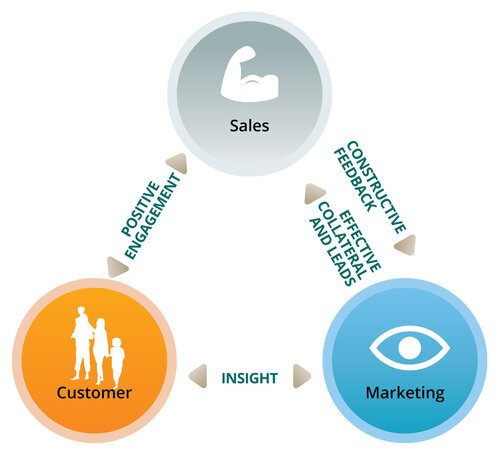Why Marketing is no longer an Underdog to Sales.
Marketing is no longer an Underdog to Sales., AdobeStock_110297979
The sales landscape has changed forever.
Buyers are taking control of the sales process. They now conduct their own online research before they contact vendors, while many outbound sales techniques, such as cold calling and direct marketing, are becoming less and less effective, particularly in B2B. General marketing practices like trade shows and events, webinars and white papers are also losing effectiveness. Buyers are simply tired of being bombarded with sales approaches, most of them unsolicited. They feel harassed, invaded, and besieged by clumsy selling techniques to the point where they have simply turned off being contacted altogether. Their knee-jerk reaction is this: "No matter what you're selling, I'm not interested!"
"No matter what you're selling, I'm not interested!"
So, vendors and sellers need to restock their sales and marketing arsenal with more sophisticated and more effective weaponry.
Cold Calling / Warm Calling
A lot of articles have been written about the pros and cons of cold calling. My colleague and co-founder of the Sales Mastermind Australasia, Tony J. Hughes, has written extensively on the subject, largely promoting cold calling as an effective sales technique. Personally, I am not a huge fan of calling somebody out of the blue, interrupting whatever they are doing and expecting them to drop everything to listen to your sales pitch. The only time this has half a chance of working is if you really have something significant up your sleeve that is of vital importance to them and to their business. If you have something like this, then please feel free to go straight on to the section below on Challenger / Disruptive / Provocative Selling.
Otherwise, my recommendation is to stay away from cold calling. Instead, warm up your prospect with Content Marketing or Social Selling (both described below) before making direct contact. In this way, at least they know who you are and that you have something that is worthy of their time, or not.
Content Marketing
This strategy requires marketing to issue content that entices and compels buyers to our business. This content is usually published to the website and online generally, and complementary material is issued to the sales team. Content may comprise white papers, thought leadership articles, client success stories and lead generation campaigns. The key to success is that marketing continuously monitors the performance of its content and actively seeks feedback from the sales team about how prospects and customers react to it. Equally, sales reps must actively provide their front line intelligence to marketing so that the performance of marketing content can continuously be improved.
Success depends largely on a highly collaborative feedback loop between sales at the customer-facing front and marketing at the online front.
Social Selling
This is a specialist version of content marketing which is practiced by individual sales reps. The idea is that we want to attract buyers not only to our brand but also to individual reps who have built a reputation of being subject matter experts.
The way it works in many organisations is that marketing provides the right content to the sales force for them to promote their personal subject matter expertise on social media platforms such as LinkedIn, Facebook or Twitter. In other words, individual sales reps attract the buyer through their personal brand, as well as their employer's brand.
Again, the success of this initiative largely depends on close collaboration between marketing and sales, if the content is to match the individual, and vice versa.
Storytelling
Storytelling is very powerful. Ever since humans were living in caves we sat around the campfire and told stories. Before the written word was invented stories were the way that we acquired information and learned new skills, such as how to hunt, gather and grow food. Even today, us humans remember stories much better than mere facts or figures.
When salespeople engage with a prospect or client they will have much deeper impact when they convey their information through a story. Storytelling also has the advantage that it doesn't feel like selling. Just telling a story or an anecdote feels less intrusive to both the buyer and the rep. So, go ahead and tell the story of how a past client found themselves in a similar situation to your current prospect and how your solution helped them to overcome their challenges and to succeed.
Your marketing team should arm your sales force with stories to regale your prospects and customers.
Account Based Marketing (ABM)
ABM is nothing new, but modern sales and marketing technology has elevated it to the latest "must-have". The reason is that it can be very powerful, if executed well. Imagine you want to win a new key account or retain a major client that is at risk of moving on to a competitor. Wouldn't you want to give them the attention they need to help secure or retain their business ? So, you create a specialist team, let's call them a "hit squad", to identify the key stakeholders in your account, i.e. the decision makers, influencers and gate keepers, and you identify what makes each of them tick, their likes and dislikes, challenges and opportunities. Then you provide each of them individually, through whatever means necessary, with the information that they need to make an informed decision on why they should buy from your organization. This is so that when they all meet to decide which vendor to go with, they will discover that they all miraculously agree that they should go with your business.
This "hit squad" must consist of a multi-disciplinary team, comprised of marketing, sales, product management and communications experts. So, once again, close collaboration between marketing and sales is the key to success here, too.
Challenger / Disruptive / Provocative Selling
I have previously written about this type of selling and why it is not suitable for every rep. However, if your sales force has people with the stature to challenge your prospects' or clients' thinking then it can be very effective. The idea is that you disrupt their thinking with some new information that they either did not previously possess, or that they had not yet considered. Something that stops them in their tracks. The neat thing is that, because this particular insight was brought to them by you and only you, it gives you instant credibility over and above your competitors and turns you into a trusted adviser. It should be easy from there on to close the deal.
Conclusion
Salespeople, now more than ever, need to work together with their marketing counterparts to get their message across and cut through the noise to be invited into a sales conversation, rather than forcing their way in.
Salespeople, now more than ever, need to work together with their marketing counterparts to get their message across and cut through the noise to be invited into a sales conversation, rather than forcing their way in.
Regardless of which of the above sales techniques you choose to go with, much of your sales performance and success will depend on how well your marketing and sales teams work together to engage the Buyer and to differentiate your business from that of your competitors.
Ideally, your marketing and sales teams will collaborate across all levels of seniority, i.e. not just at
executive level, and do so right across the entire 360 degree spectrum to include your customers as well, as illustrated above.
If this article resonates with your thinking then talk to us about your options.
About The Author
Peter Strohkorb is the CEO of Peter Strohkorb Consulting International, a published Author, an international Speaker and Executive Marketing and Sales Mentor, as well as an Executive MBA guest Lecturer.
Peter developed the 5-Step OneTEAM Method®, which is the only structured program to lift business performance through superior and sustainable collaboration between your two most customer-facing and revenue-generating functions, namely Marketing and Sales.
Peter welcomes your inquiries.
"We deliver Collaboration, Growth, Success from within just 12 weeks."
Join Peter's LinkedIn Community
If the subject of Sales and Marketing alignment and collaboration is of interest to you then please join my LinkedIn group, the Sales+Marketing Collaboration Community.
Buy Peter's Book
Peter Strohkorb's book "The OneTEAM Method" has received international critical acclaim.
You can download the first chapters free of charge.
The full version is available on Amazon.


